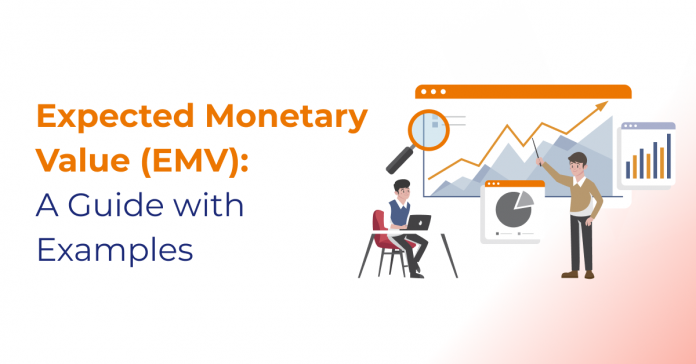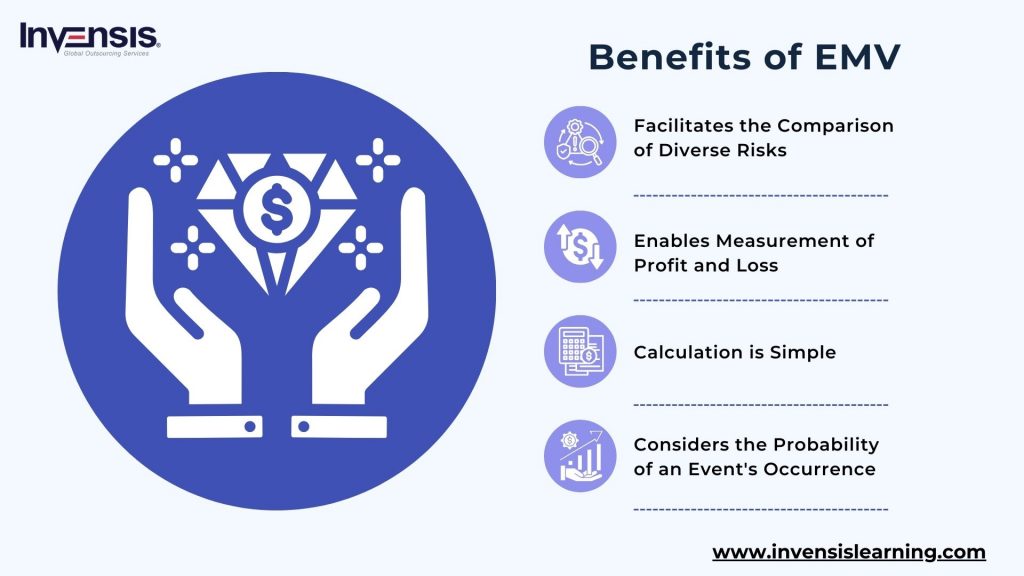
Do you ever feel unsure about a decision’s financial impact, especially in project management? Uncertainty can cloud judgment, whether it’s a business venture or an everyday choice. But what if there was a tool to help you see the bigger financial picture? Expected Monetary Value (EMV) can be your secret weapon.
Expected Monetary Value is one tool that project managers frequently use to assess, manage, and develop effective project risk management strategies. This blog will help you understand and utilize EMV. We’ll explain the concept, explain its calculation, and explore how it can be applied to various situations.
With Expected Monetary Value, you can make informed decisions with a clearer idea of the potential financial outcomes, ensuring project success.
Table of Contents
- What is the Expected Monetary Value?
- Understanding Expected Monetary Value with Examples
- Why Opt for Expected Monetary Value?
- Expected Monetary Value Methodology
- Expected Monetary Value Alternatives
- Conclusion
What is the Expected Monetary Value?
Expected Monetary Value is a statistical concept used in decision theory and risk management to quantify the potential value of an outcome or decision by considering both its probability of occurrence and its monetary impact.
It represents the average financial gain or loss expected from a particular decision or scenario, considering the probabilities of different outcomes. It allows decision-makers to assess the risks associated with various options and make informed choices based on their expected financial outcomes.
The formula for Expected Monetary Value (EMV) is expressed as:
EMV = Probability × Impact
In this equation:
- Probability denotes the likelihood of a specific outcome happening, expressed as a percentage ranging from 0% to 100%
- Impact signifies the financial consequence of the outcome, which can range from negative to positive, depending on its effect on the firm’s financial performance
By understanding and calculating EMV, individuals and organizations can better manage uncertainty, prioritize actions, and optimize decision-making processes across a wide range of domains, including business, finance, project management, and insurance.
Understanding Expected Monetary Value with Examples
Expected Monetary Value is a decision-making tool that helps you assess the average financial outcome of different options, considering both the likelihood of each outcome and its potential reward or loss.
Let’s dive into some examples to illustrate how EMV works:
-
Insurance Claim Decision
Consider a scenario where an insurance company evaluates the potential impact of offering a new insurance policy against cyberattacks. They estimate a 5% chance of a cyberattack occurring, with an average financial loss of $500,000 for each attack. To calculate the Expected Monetary Value (EMV) for this insurance policy:
Probability of cyberattack = 5%
Financial impact of cyberattack = $500,000
EMV = Probability*Impact
EMV = 0.05*$500,000
EMV = $25,000
This implies that if the insurance company were to offer this policy repeatedly in similar circumstances, they would expect to pay out an average of $25,000 for each policy due to cyberattacks.
-
Project Management Decision
Imagine a project manager is considering whether to invest in upgrading the software used by their team. They estimate there’s a 20% chance that the software upgrade will encounter compatibility issues with existing systems, resulting in a delay that could cost the company $50,000 in lost productivity.
To calculate the Expected Monetary Value of this decision:
Probability of compatibility issues = 20%
Financial impact of delay = $50,000
EMV = Probability*Impact
EMV = 0.20*$50,000
EMV=$10,000
This indicates that if the project manager were to proceed with the software upgrade multiple times under similar circumstances, they would expect an average loss of $10,000 per upgrade due to the risk of compatibility issues.
Why Opt for Expected Monetary Value?
The benefits of Expected Monetary Value lie in its ability to provide decision-makers with a systematic and quantitative approach to evaluating potential outcomes and guiding strategic choices.
Here are some key benefits:
-
Facilitates the Comparison of Diverse Risks
Expected Monetary Value (EMV) allows decision-makers to assess and compare risks on a common scale, bringing clarity to the decision-making process. By quantifying the potential financial outcomes of various scenarios, expected monetary value enables a systematic evaluation of risks across different projects, investments, or decision options.
This facilitates informed decision-making by providing a clear basis for comparing the relative riskiness of alternative courses of action.
-
Enables Measurement of Profit and Loss
It provides a structured framework for measuring potential gains and losses associated with different decisions or scenarios. By calculating the expected financial outcome of each option, decision-makers can assess the potential profitability or cost-effectiveness of their choices.
This enables organizations to prioritize actions that offer the greatest potential for positive financial outcomes while mitigating the impact of potential losses.
-
Calculation is Simple
One of the Expected Monetary Value’s key advantages is its simplicity in calculation, making the audience feel at ease with the process. The formula for EMV involves multiplying the probability of each possible outcome by its corresponding monetary value and summing the results.
This straightforward calculation process makes expected monetary value accessible to a wide range of decision-makers, regardless of their mathematical expertise, and allows for quick and efficient analysis of different scenarios.
-
Considers the Probability of an Event’s Occurrence
It takes into account not only the potential financial impact of different outcomes but also the likelihood of those outcomes occurring. By incorporating the probability of each event’s occurrence, Expected Monetary Value provides a more accurate representation of the expected financial outcome of a decision or scenario.
This probabilistic approach helps decision-makers assess and manage risks more effectively by considering the potential rewards and the likelihood of experiencing adverse events.
Expected Monetary Value Methodology
Now that we understand the significance of expected monetary value and how it aids decision-making, let’s delve into the practical steps of calculating it for a specific project. You can employ this template to assess your project’s expected monetary value, irrespective of its nature.
To begin, enumerate all the potential risks and opportunities associated with your project, their respective probabilities of occurrence, and financial impacts. For instance, envision you’re gearing up to launch a new product. Among the risks and opportunities you might encounter are:
- A competitor is launching a similar product ahead of you (30% probability, -$100,000 negative impact)
- One of your critical suppliers is going bankrupt (10% probability, -$50,000 negative impact)
- The launch date is advancing by 2 months (20% probability, +$20,000 positive impact)
Once you’ve identified these factors, proceed to calculate the expected monetary value (EMV) for each. As demonstrated by the formula, this involves multiplying the probability of each risk by its potential impact. For instance, for the risk of a competitor launching a similar product:
???=0.3×(?$100,000)=(?)$30,000
Similarly, for the other risks:
- Supplier bankruptcy:
???=0.1×(?$50,000)=(?)$5,000
- Launch date advancement:
???=0.2×(+$20,000)=(+)$4,000
Upon computing the EMV for each risk, the final step is to aggregate all individual EMVs to derive your project’s total expected monetary value. In our example, this calculation yields:
Total EMV=(?)$30,000+(?)$5,000+(+)$4,000=(?)$31,000
This figure represents the average financial outcome you can anticipate for your project, factoring in risks and opportunities. It serves as a valuable metric for decision-making.
Expected Monetary Value Alternatives
Expected monetary value alternatives refer to alternative methods or approaches that can be used in decision-making and risk assessment processes when EMV may not be suitable or applicable. While Expected Monetary Value is a widely used and effective tool for evaluating the financial implications of decisions and assessing risks, there are situations where other methods may be more appropriate or complementary.
Some common alternatives to Expected Monetary Value include:
-
Expected Value
Expected value, often denoted as EV, serves to quantify the average outcomes of a series of activities. It involves multiplying each potential outcome by its probability of occurrence and summing these products.
However, this calculation assumes that all outcomes are equally likely, which may not reflect real-world scenarios accurately. The formula for Expected Value is:
EV=?(Probability×Outcome)
While straightforward, EV may not always be suitable in real-time project scenarios where outcomes vary in likelihood.
-
Standard Deviation
Standard deviation, represented as SD, provides insight into the spread or variability of a dataset. A higher standard deviation indicates a wider range of values, while a lower standard deviation suggests data points are closer to the average.
In project management, the standard deviation is utilized as a risk quantification measure, helping to understand the deviation of actual outcomes from the expected value.
The formula for standard deviation is:
SD or ? = ??((x-?)2/n)
Here, ? represents the mean value, and n denotes the number of data points.
-
Monte Carlo Simulations
Monte Carlo simulations employ modeling and analysis techniques to gauge the probability of various outcomes by running a large number of trials. By simulating different scenarios, Monte Carlo simulations provide estimates of the likelihood of outcomes and identify which outcomes may occur more frequently than others.
This helps decision-makers allocate resources and attention accordingly.
-
Sensitivity Analysis
Sensitivity Analysis, abbreviated as SA, involves analyzing outcomes under varied or updated inputs. It complements EMV decision analysis by identifying inputs that exert the most significant influence on project outcomes.
By scrutinizing the sensitivity of outcomes to changes in input variables, sensitivity analysis enhances the EMV calculation, yielding more nuanced insights into potential outcomes.
Conclusion
Expected Monetary Value (EMV) is a vital tool for project managers, aiding in risk assessment and response planning. By quantifying scenarios based on risk probability and impact, EMV facilitates informed decision-making and effective risk prioritization. It enables objective choices, easing trade-off situations and optimizing resource allocation. With EMV, project managers can navigate uncertainties confidently, ensuring project success and stakeholder satisfaction.
Mastering financial decisions in project management? Invensis Learning’s Project Management Certification Courses can be your guide. Our programs equip you with the knowledge to leverage EMV for informed choices. Confidently evaluate risks, optimize resource allocation, and gain industry-recognized credentials. Elevate your project management career with Invensis Learning!















